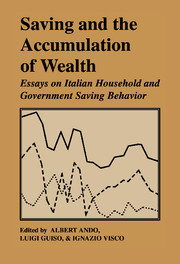Book contents
- Frontmatter
- Contents
- Foreword by Antonio Fazio
- List of contributors
- List of figures
- List of tables
- Acknowledgments
- Introduction
- I Saving trends, government deficit and demographic changes
- 1 Why is Italy's saving rate so high?
- 2 Private saving and the government deficit in Italy
- 3 Do demographic changes explain the decline in the saving rate of Italian households?
- 4 Generational accounting. The case of Italy
- II Life-cycle saving and precautionary motives
- III Borrowing constraints, intergenerational transfers and bequests
- Appendixes
- Index
1 - Why is Italy's saving rate so high?
Published online by Cambridge University Press: 05 May 2010
- Frontmatter
- Contents
- Foreword by Antonio Fazio
- List of contributors
- List of figures
- List of tables
- Acknowledgments
- Introduction
- I Saving trends, government deficit and demographic changes
- 1 Why is Italy's saving rate so high?
- 2 Private saving and the government deficit in Italy
- 3 Do demographic changes explain the decline in the saving rate of Italian households?
- 4 Generational accounting. The case of Italy
- II Life-cycle saving and precautionary motives
- III Borrowing constraints, intergenerational transfers and bequests
- Appendixes
- Index
Summary
Introduction
Two features characterize the Italian saving rate. By international standards, Italy is a “high–saving” country; the Italian saving rate has declined markedly in the last three decades. We provide a consistent framework to interpret these facts. According to the life–cycle hypothesis, they should be explained mainly by differences in demographics and productivity growth between countries and over time (Modigliani, 1990). However, as we argue in Section 2, the differences in the growth rates between Italy and the other major OECD countries are rather small when compared with the large differences in their saving rates: growth appears to generate more saving in Italy than elsewhere. Thus, growth alone cannot account for the high Italian saving rate and for its sharp decline.
We argue that capital market imperfections provide a plausible explanation of the evidence. An economy in which households are liquidity-constrained exhibits a higher saving rate than an economy with perfect markets, even if the two economies grow at the same rate. This implies that an identical reduction in growth leads to a greater reduction in saving in the economy with imperfect markets (Jappelli and Pagano, 1994). Thus, the interaction between growth and capital market imperfections may explain not only why Italy's saving rate is high; it may also explain why the reduction in the rate of productivity and population growth of the eighties was accompanied by a sharp reduction in saving.
Information
- Type
- Chapter
- Information
- Saving and the Accumulation of WealthEssays on Italian Household and Government Saving Behavior, pp. 23 - 69Publisher: Cambridge University PressPrint publication year: 1994
Accessibility standard: Unknown
- 20
- Cited by
